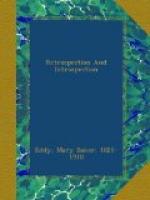The parable of “the prodigal son” is rightly called “the pearl of parables,” and our Master’s greatest utterance may well be called “the diamond sermon.” No purer and more exalted teachings ever fell upon human ears than those contained in what is commonly known as the Sermon on the Mount,—though this name has been given it by compilers and translators of the Bible, and not by the Master himself or by the Scripture authors. Indeed, this title really indicates more the Master’s mood, than the material locality.
Where did Jesus deliver this great lesson—or, rather, this series of great lessons—on humanity and divinity? On a hillside, near the sloping shores of the Lake of Galilee, where he spake primarily to his immediate disciples.
In this simplicity, and with such fidelity, we see Jesus ministering to the spiritual needs of all who placed themselves under his care, always leading them into the divine order, under the sway of his own perfect understanding. His power over others was spiritual, not corporeal. To the students whom he had chosen, his immortal teaching was the bread of Life. When he was with them, a fishing-boat became a sanctuary, and the solitude was peopled with holy messages from the All-Father. The grove became his class-room, and nature’s haunts were the Messiah’s university.
What has this hillside priest, this seaside teacher, done for the human race? Ask, rather, what has he not done. His holy humility, unworldliness, and self-abandonment wrought infinite results. The method of his religion was not too simple to be sublime, nor was his power so exalted as to be unavailable for the needs of suffering mortals, whose wounds he healed by Truth and Love.
His order of ministration was “first the blade, then the ear, after that the full corn in the ear.” May we unloose the latchets of his Christliness, inherit his legacy of love, and reach the fruition of his promise: “If ye abide in me, and my words abide in you, ye shall ask what ye will, and it shall be done unto you.”
WAYMARKS
In the first century of the Christian era Jesus went about doing good. The evangelists of those days wandered about. Christ, or the spiritual idea, appeared to human consciousness as the man Jesus. At the present epoch the human concept of Christ is based on the incorporeal divine Principle of man, and Science has elevated this idea and established its rules in consonance with their Principle. Hear this saying of our Master, “And I, if I be lifted up from the earth, will draw all men unto me.”
The ideal of God is no longer impersonated as a waif or wanderer; and Truth is not fragmentary, disconnected, unsystematic, but concentrated and immovably fixed in Principle. The best spiritual type of Christly method for uplifting human thought and imparting divine Truth, is stationary power, stillness, and strength; and when this spiritual ideal is made our own, it becomes the model for human action.




